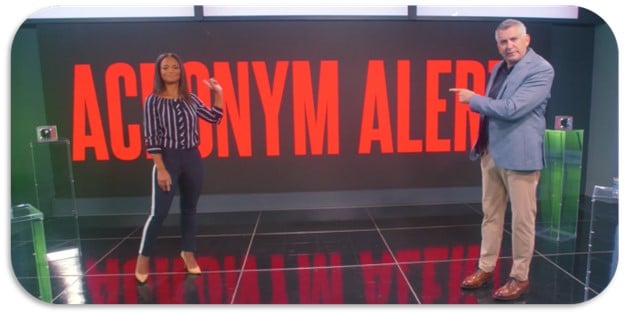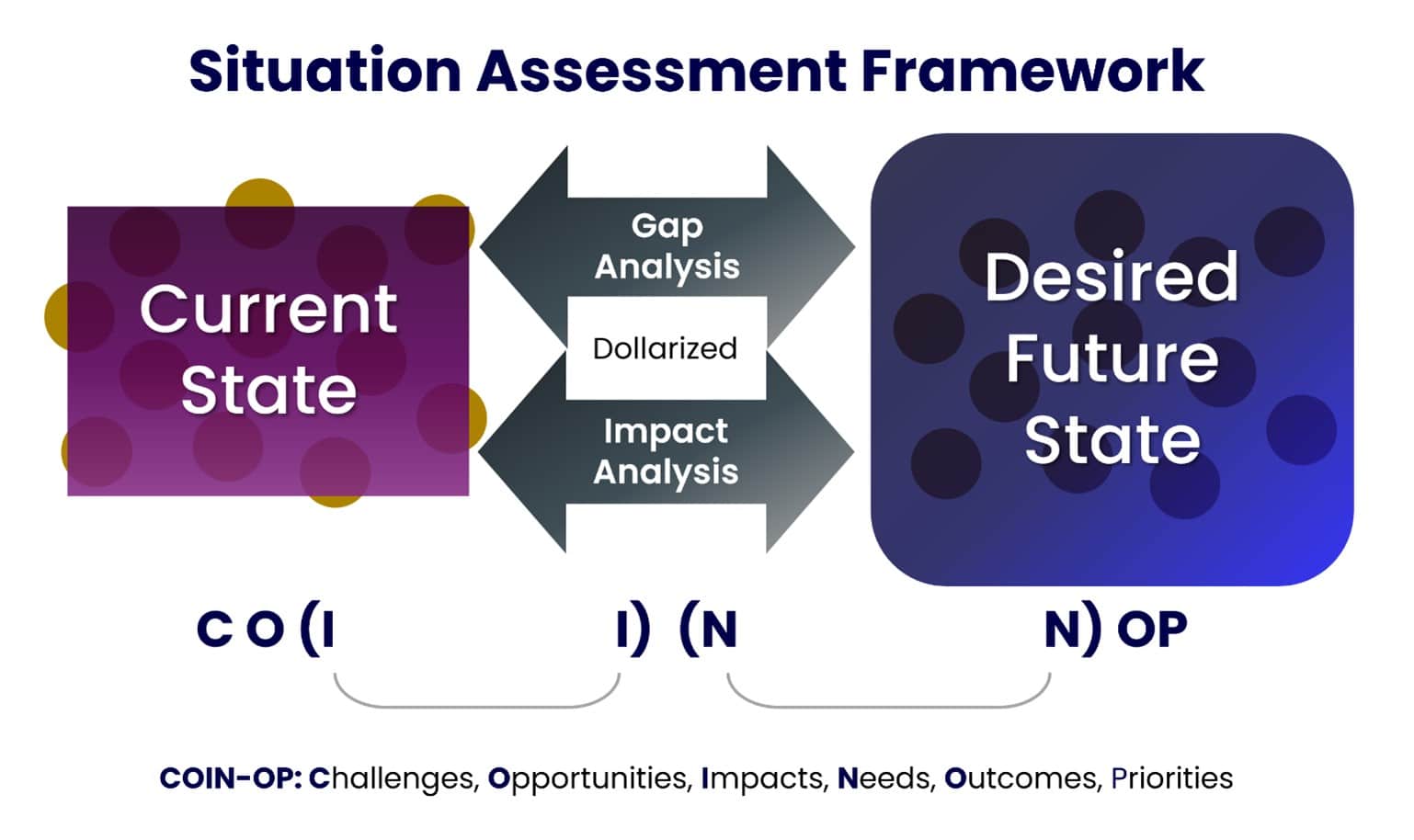In a moment of silly fun in our Modern Sales Foundations video course, we have an Acronym Alert that goes off when one of the co-hosts mentions an acronym. It’s a fairly obnoxious sound (on purpose), and it usually gets a chuckle.

We need this in real life, don’t we? If I’ve learned anything in 37 years in business, we love our acronyms. In most companies where I’ve worked, we needed to provide an acronym list to new hires.
What I doubt you’ve ever heard someone say, though, is that a group of acronyms can help you improve the effectiveness of your sales force. I’m saying that now, in this post, and despite my typically light-hearted approach, I am deadly serious on this topic.
Alphabet Soup for Sales
The acronyms of note for this post are:

Let’s explore what these mean and the value the concepts behind them can deliver for you and your sales force.
COIN-OP
COIN-OP can serve your sales effectiveness efforts in two ways. It becomes most powerful when plugged into the Situation Assessment Framework I referenced previously in my DSG posts.

COIN-OP Use Case 1: Sales Discovery
In this framework, COIN-OP can be used as a sales discovery tool to deeply understand your prospects’ and customers’ situations.
- C, O, and I will help you understand their current state, with the challenges they face, the opportunities they can capitalize on, and the impacts of this current state (and of not resolving the challenges or not capitalizing on the opportunities, which indicate risks of inaction).
- O and P help define the desired future state, with the outcomes they seek and the priority of those outcomes, compared to the current state.
- The N, or needs, result from a gap analysis between the states. The needs define what it will take to close the gap and achieve the desired future state.
With these understood and documented, the seller can conduct an impact analysis to dollarize the gains and weigh them against the costs of the solution and the pain of change. Whether this is done at a higher level for a transactional sale or done deeply for a consultative sale with a bespoke solution to solve a complex problem, this is how sellers can create a compelling business case for change and spur action.
Note: A Situation Assessment, done well, provides a service to your buyers by helping them better think through their situation and detail their needs. A CEO of a major corporation once thanked our CEO for walking her through COIN-OP over a series of meetings and deep discussions. I know it sounds hard to believe, but I’ve heard this multiple times. When you guide someone through the process and ask thoughtful questions, it’s a form of servant leadership.
COIN-OP Use Case 2: Internal Sales Force Assessment
Now, imagine using this framework to assess the situation at your company with your own sales force. Along with a solid understanding of Who Sells What to Whom and How, the Situation Assessment with COIN-OP is a powerful diagnostic tool for sales performance improvement. I teach this to new sales enablement professionals and even experienced leaders who want to evolve their current enablement practice. It’s powerful and it works.
ACC

Moving from a conceptual framework to a human differentiator, I introduce you to the ACC model. I’ve taught this for years but didn’t always use this acronym. Our script writers coined the acronym recently and I’m glad they did. On a funny note, it always reminds me of Bloom County’s Bill the Cat character, who says “Ack!” when he coughs up hairballs. But that visual aside, the ACC acronym is an incredibly powerful communication model.
- Acknowledge: This is a statement to demonstrate empathy and let buyers know that you heard and understood what they shared with you – the content and their feelings or thoughts. When acknowledging, avoid “I Statements.” Use “You Statements” instead to phrase your acknowledgment from your buyer’s perspective.
- Clarify: This is about digging deeper. Don’t assume you fully understand or stay at the surface level. Ask questions to clarify the information buyers share and dig even deeper. “Peel the onion” to uncover root causes and motivations (the “why” behind the “what”).
- Confirm: This is where you summarize to verify what you heard and validate that your interpretation matches your buyer’s intention. This step ensures communication has occurred and that you are aligned before moving forward.
It’s so easy for things to go haywire during communication. If you don’t use a model like ACC, you might not even know there was a miscommunication. While it’s a simple model, this is what makes it important and valuable.

Read more about ACC here.
Buyers frequently report feeling misunderstood by sellers. The COIN-OP framework and ACC model are wonderful remedies. In fact, during discovery, your sellers should use ACC frequently (done well, it’s very conversational) while detailing COIN-OP.
NASA
Using the Situation Assessment Framework with COIN-OP and ACC will also allow you to determine whether you have NASA. (I used to joke that “you can’t launch a sale without NASA,” but Musk, Bezos and Branson wrecked that for me.) In this case, as you know from above, NASA means Need And Solution Alignment.
This is where a salesperson evaluates how well their solution aligns with their buyer’s true needs. Will it resolve the Challenges or enable the Opportunities? How well and to what degree? For the salesperson, it also illuminates whether they have a strong NASA.
With a foundation of NASA, sellers can proceed confidently to explore, co-create or present their solution. And, with a strong NASA and business case, it gives them comfort to ethically influence and persuade, if needed, to get a wary or cautious buyer or committee to take action.
Read more here and here (including more about FACT, which is next).
FACT
Combined with NASA, FACT is a qualification model.
- Funding: Do the buyers with whom you’re speaking have a budget or line item for your solution? If not, more importantly, can they source the necessary funds to purchase your solution?
- Alternatives: What are you up against? Be sure to consider direct competitors and other ways of solving the problem, such as DIY and, of course, doing nothing (the status quo). Also, consider whether they are just loosely exploring options as a reality check against their current supplier.
- Committee: Are you working with, and do you have access to, the right decision- makers? Beyond the ability to make a purchase decision, this also ties to Funding. If this is not a planned expense, are you working with a Financial Decision-Maker, Approver or Champion on the buying committee who can make the purchase decision and obtain the funds?
- Timing: How soon do they need a solution? Can you deliver it the timeframe they need? (This is certainly a key concern for distributors today, with the current supply chain constraints.) On the other side of the coin, is a compelling event driving the decision, creating urgency or encouraging a firm timeline? Or are they just casually exploring ideas?
Each of these qualification FACTs, if not recognized and accounted for, can result in your opportunities entering limbo, going dark or dragging on forever, eventually ending in a Closed-Lost or No-Decision status.
Let’s End with an ICE WAR
Hopefully, you can see how four simple acronyms can improve your sales effectiveness. In fact, one might even say that you can Improve Commercial Excellence With Acronym Results!
If this post helps you in any way on your journey toward improved sales effectiveness, feel free to let me know. I’d enjoy hearing about your successes.
Mike Kunkle is an internationally recognized expert on sales enablement, sales effectiveness, sales training, sales coaching, sales management, and sales transformations.
He’s spent over 30 years helping companies drive dramatic revenue growth through best-in-class enablement strategies and proven effective sales systems.
Mike is the founder of Transforming Sales Results, LLC where he designs sales training, delivers workshops, and helps clients improve sales results through a variety of sales effectiveness practices and advisory services.
He collaborated to develop SPARXiQ’s Modern Sales Foundations™ curriculum and authored their Sales Coaching Excellence™ and Sales Management Foundations™ courses.
Mike's book, The Building Blocks of Sales Enablement, is available on Amazon, with others coming soon in 2026, starting with The CoNavigator Method for B2B Selling.

